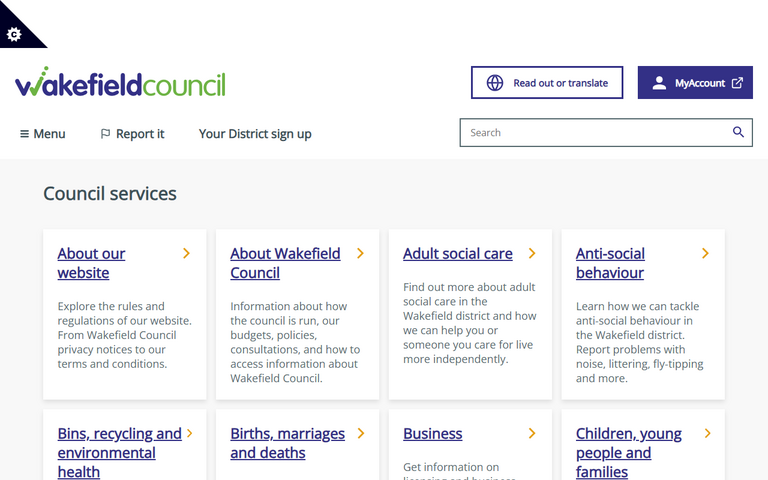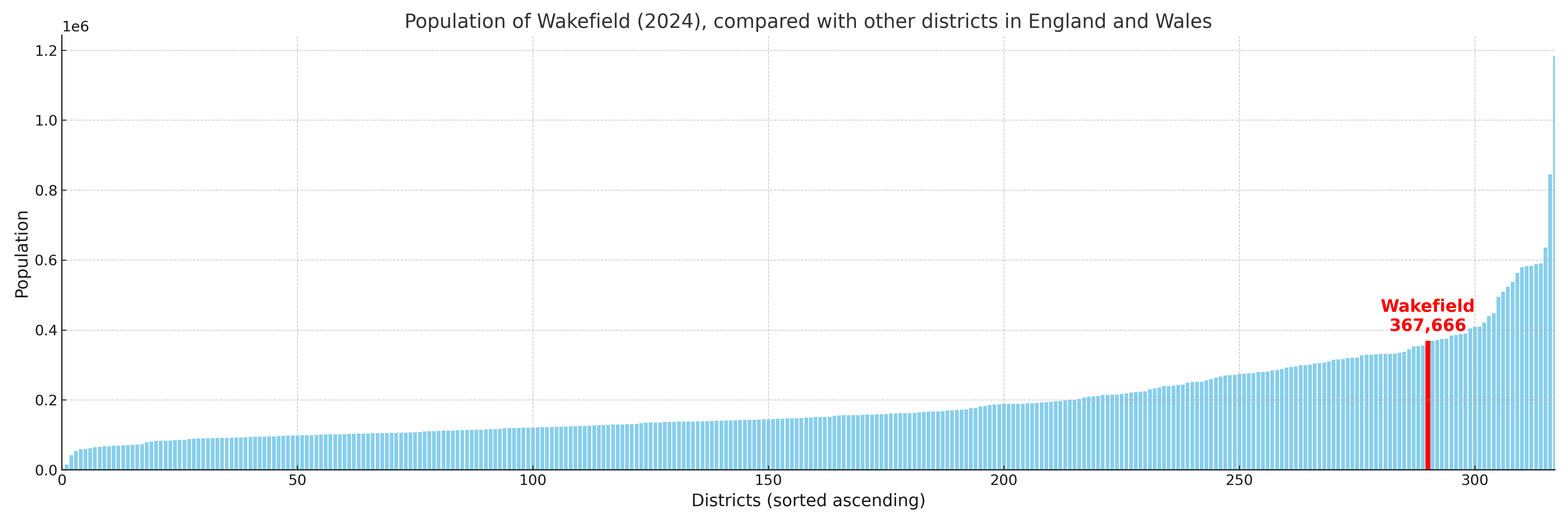Wakefield
§ This page gives an overview of the Wakefield local authority district, bringing together key facts, maps, and data to help you quickly understand the area. One of 361 district profiles on Baseview.
Overview ⁞ Wakefield, on the River Calder, is a West Yorkshire city surrounded by market towns, villages, and countryside. The city itself features Wakefield Cathedral with its soaring spire, the Hepworth Wakefield art gallery, and historic markets. The district includes Pontefract, with its medieval castle and racecourse, and Castleford, known for its Roman history and riverside walks. The surrounding landscape includes rivers, canals, and former coalfield areas transformed into country parks and nature reserves, such as Anglers Country Park. Wakefield’s blend of historic towns, waterways, and green spaces creates a varied setting.
Wakefield Boundary Map
This map shows the official boundary of the Wakefield local authority district, based on the latest geographic data published by the Office for National Statistics (ONS). It provides a clear view of the district’s extent and helps you understand how the area fits within the wider regional and national landscape.
Contains OS data © Crown copyright and database right 2025. Source: Office for National Statistics licensed under the Open Government Licence v3.0.
The administrative boundary of Wakefield can also be viewed on OpenStreetMap: District Boundary of Wakefield.
Key Facts about Wakefield
What region is Wakefield in? Wakefield is in the Yorkshire and The Humber of England, a region within the UK.
What county is Wakefield in? Wakefield is located in the county of West Yorkshire.
Is Wakefield a city? Yes, Wakefield is a city. Wakefield holds official city status as one of the 76 designated cities in the UK.
Who governs Wakefield? The local government for this district is: Wakefield City Council (Metropolitan District).
▶ Official website of Wakefield City Council 🔗 wakefield.gov.uk

Which police force covers Wakefield? Policing in Wakefield is provided by West Yorkshire Police 🔗 westyorkshire.police.uk, which serves 5 local authority districts: Bradford ⁞ Calderdale ⁞ Kirklees ⁞ Leeds ⁞ Wakefield.
Wakefield in International Geographies
In the International Territorial Levels (ITLs) hierarchy, Wakefield is an ITLs Level 3 area:
- (ITL 1) Yorkshire and The Humber
- (ITL 2) ⇒ West Yorkshire
- (ITL 3) ⇒⇒ Wakefield
The International Territorial Levels are used by OECD member countries for statistical purposes to classify administrative areas. We have this listable page for easy browsing of ITL names and codes: International Territorial Levels.
Constituencies in Wakefield
Wakefield is divided into 4 parliamentary constituencies, listed below in alphabetical order.
- Normanton and Hemsworth
- Ossett and Denby Dale
- Pontefract, Castleford and Knottingley
- Wakefield and Rothwell
A constituency is a specific geographical area that elects one Member of Parliament (MP) to represent them in the House of Commons. The United Kingdom is divided into 650 parliamentary constituencies, 54 of them are in Yorkshire and the Humber region. We have this list page for easy browsing of all UK parliamentary constituencies: List of Constituencies.
Wards in Wakefield
Wakefield is divided into 21 wards, listed below in alphabetical order.
- Ackworth, North Elmsall and Upton
- Airedale and Ferry Fryston
- Altofts and Whitwood
- Castleford Central and Glasshoughton
- Crofton, Ryhill and Walton
- Featherstone
- Hemsworth
- Horbury and South Ossett
- Knottingley
- Normanton
- Ossett
- Pontefract North
- Pontefract South
- South Elmsall and South Kirkby
- Stanley and Outwood East
- Wakefield East
- Wakefield North
- Wakefield Rural
- Wakefield South
- Wakefield West
- Wrenthorpe and Outwood West
In the UK, a ward is a subdivision of a local authority area, used mainly for electoral and statistical purposes. Defined by the ONS, wards represent the primary unit for local elections, each returning one or more councillors to the local council. Wards are also used as a key geography for presenting population and census data.
Parishes in Wakefield
Wakefield is part-parished: 29 civil parishes (listed A-Z below) alongside 6 unparished areas.
- Ackworth
- Badsworth
- Chevet
- Crigglestone
- Crofton
- Darrington
- East Hardwick
- Featherstone
- Havercroft with Cold Hiendley
- Hemsworth
- Hessle and Hill Top
- Huntwick with Foulby and Nostell
- Newland with Woodhouse Moor
- Normanton and Altofts
- Notton
- Ryhill
- Sharlston
- Sitlington
- South Elmsall
- South Hiendley
- South Kirkby and Moorthorpe
- Thorpe Audlin
- Upton and North Elmsall
- Walton
- Warmfield cum Heath
- Wentbridge
- West Bretton
- West Hardwick
- Woolley
A civil parish is the lowest tier of local government in England, used for villages, small towns, and suburbs. They have their own local authority, either a parish council or a parish meeting, which provides local services like managing parks, allotments, and streetlights, and represents the community's views to larger councils.
Built-up Areas in Wakefield
Wakefield covers 41 built-up areas, listed below in alphabetical order.
- Ackworth Moor Top
- Badsworth
- Bottom Boat
- Brotherton *
- Castleford *
- Coxley (Wakefield)
- Crigglestone and Durkar
- Crofton
- Darrington
- Darton *
- Dewsbury *
- Featherstone (Wakefield)
- Fitzwilliam and Kinsley
- Hall Green
- Havercroft and Ryhill
- Hemsworth
- High Ackworth
- Holmfield *
- Horbury
- Kirkhamgate *
- Knottingley
- Lofthouse and Robin Hood *
- Low Ackworth
- Middlestown and Overton
- Netherton (Wakefield)
- Normanton (Wakefield)
- Notton (Wakefield)
- Ossett *
- Pontefract
- Royston (Barnsley) *
- Sharlston
- South Elmsall
- South Hiendley
- South Kirkby
- Streethouse
- Thorpe Audlin
- Upton (Wakefield)
- Wakefield *
- Walton (Wakefield)
- West Bretton
- Woolley
In the UK, a Built-up Area (BUA) is a continuous urban area of at least 20 hectares (0.2 km²), defined by the ONS as land where buildings are generally no more than 200 metres apart, such as towns, cities, or large villages. (Note: A BUA name marked with an asterisk (*) indicates that the area is situated partly in the district of Wakefield.)
Wakefield compared with other districts in the UK
This section shows how Wakefield compares with other local authority districts in the UK, using a variety of measures and rankings.
Wakefield has 21 electoral wards.

Wakefield has a population of 367,666 (2024 mid-year estimate by ONS)

More local statistics and data for Wakefield can be found on the ONS statistics for Wakefield.